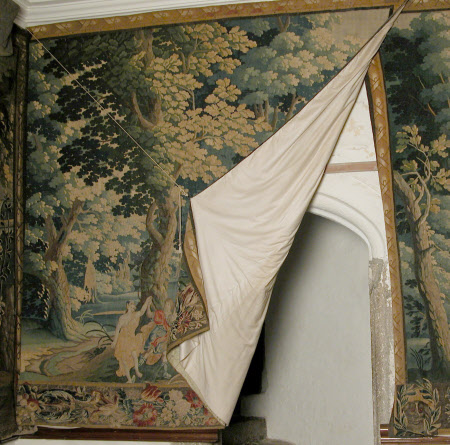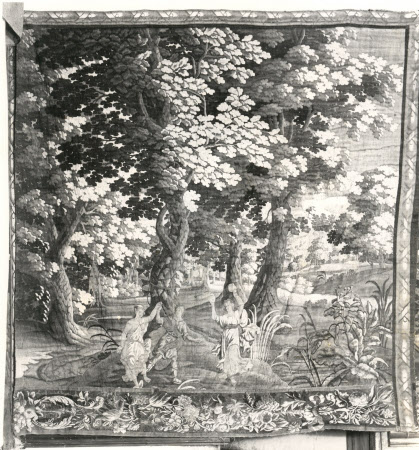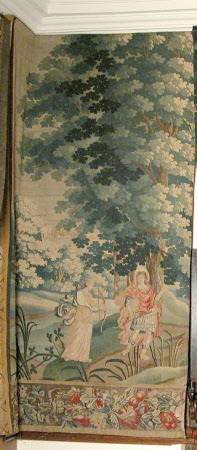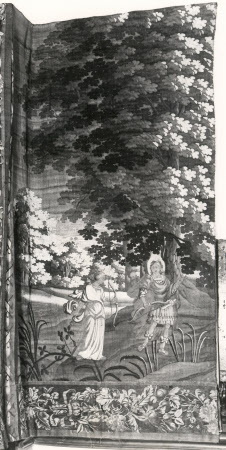Verdure with Figures Dancing with Cymbals
Flemish
Category
Tapestries
Date
circa 1680 - circa 1710
Materials
Tapestry, wool and silk, 7 warps per cm
Measurements
2430 x 2320 mm
Place of origin
Belgium
Order this imageCollection
Cotehele, Cornwall
NT 348247.4
Summary
Tapestry, wool and silk, 7 warps per cm, Verdure with Figures Dancing with Cymbals from a series of Verdures with Small Figures, Flemish, probably Antwerp or Oudenaarde, c. 1680-1710. A wooded landscape with large trees extending into the distance. Plants grow in the foreground on the right, and in the centre are three small dancing figures, a man and a woman holding hands and another woman holding cymbals above her head. The narrow right-hand border consists of a band decorated with crossed ribbons woven to imitate a carved and gilded wooden frame; the lower section of this border has been sewn on, probably from elsewhere within the same tapestry set. The upper border follows the same crossed ribbon design and may also have been sewn on, and at the bottom a wider border of fruit and foliage with lion masks at either end on a worn dark brown ground has been attached from an unrelated tapestry.
Full description
The three dancing figures are taken from two prints from a series by Pierre Brebiette (c. 1598-1642), showing nymphs and satyrs dancing and playing with goats. The dancing man on the left was a Satyr in Brebiette’s original print and in the tapestry he has been given human legs and transformed into a man. Further figures from both prints have been used in other tapestries in the set (348247.2, 3). A version of the same tapestry design with similar borders was sold in London in 1931 (Marillier Tapestry archive). Although little known today Pierre Brebiette was one of the most inventive and original of the seventeenth-century French painter-printmakers and was highly regarded by contemporary connoisseurs and collectors (Orléans 2002, pp. 8-9). The series of prints used in these tapestries, known as the ‘Douze Grandes Frises’ (‘twelve large friezes’)were made while Brebiette was in Rome from 1617-1624,. The friezes are populated by a mixture of satyrs, vestal virgins, putti, goats and other animals engaged in revelry, dancing, feasting, religious rites and sacrifices, often overseen by a high priest or by a God such as Bacchus or Pan. All the images are permeated by a wild and dream-like atmosphere. The designer of the Cotehele ‘Verdures’ has used figures from three different prints from the ‘Grandes Frises’, reversing them and inserting them into the wooded landscape backgrounds that were the stock-in-trade of many late seventeenth-century Flemish tapestry producers. Brebiette’s figures are combined with others whose sources have not been identified, but which probably also derive from prints. There is no discernable narrative to the tapestry series but the scenes are united by a general pastoral theme, drawing on but toning down the unruly bacchanalian revelry of Brebiette’s prints and adding more civilised and contemplative elements such as the figure of Apollo, and a shepherd playing a flute to two pensive companions. The tapestries have hung in the Dining Room at Cotehele since at least c. 1840, when they were noted by the Rev. Arundell – he identified the figures of Diana and Apollo in 348247.1, but noted that it was “not easy to decide upon” the subject of the series (Arundell 1840, p. 13). None of the tapestries is signed, and it is difficult to assign them to a particular weaving centre. Tapestries described as ‘verdures with small figures’ appear frequently in the records of tapestry producers and dealers in many different weaving centres in the late seventeenth century. Such tapestries occur frequently, for example, in the records of the Antwerp firm of the Wauters family who supplied so many of the tapestries at Cotehele; but many other Antwerp firms also produced them, as did weavers in Oudenaarde and other centres working for Antwerp dealers. Such tapestries were often cheaper than sets with large figures as they required less skill to weave, were made with a higher wool content, and were often, but not always, more coarsely woven than historical subjects. Nonetheless these tapestries should not be disregarded as unimportant. The Verdure was the descendant of the medieval ‘millefleurs’, and was extremely popular from the early period right through the seventeenth century. Surviving inventories reveal that in the sixteenth and seventeenth centuries ‘verdure’ tapestries formed the bulk of many tapestry collections. Composed largely of greenery sometimes interspersed with small figures and animals, a suit of verdure hangings could transform an interior such as the Dining Room at Cotehele into a forest or a garden. The lower borders on all five tapestries in the set have been attached from the ‘Orpheus and Eurydice’ series, only one panel from which survives at Cotehele, in the Dining Room (348246). (Helen Wyld, 2010)
Provenance
First recorded at Cotehele c. 1840; left at Cotehele when the property was accepted in lieu of tax from Kenelm, 6th Earl of Mount Edgcumbe (1873-1965) and transferred to the National Trust in 1947; amongst the contents accepted in lieu of estate duty by H M treasury and transferred to the National Trust in 1974.
Credit line
Cotehele House, The Edgcumbe Collection (The National Trust)
Makers and roles
Flemish, workshop possibly Antwerp , workshop possibly Oudenaarde, workshop after Pierre Brébiette (c.1598 - 1650) , artist
References
Orléans, 2002: Seule la Peinture… Pierre Brebiette, exh. cat. Musée des Beaux-Arts d’Orléans 2002 Delmarcel, 1999: Guy Delmarcel, Flemish Tapestry, Tielt 1999



